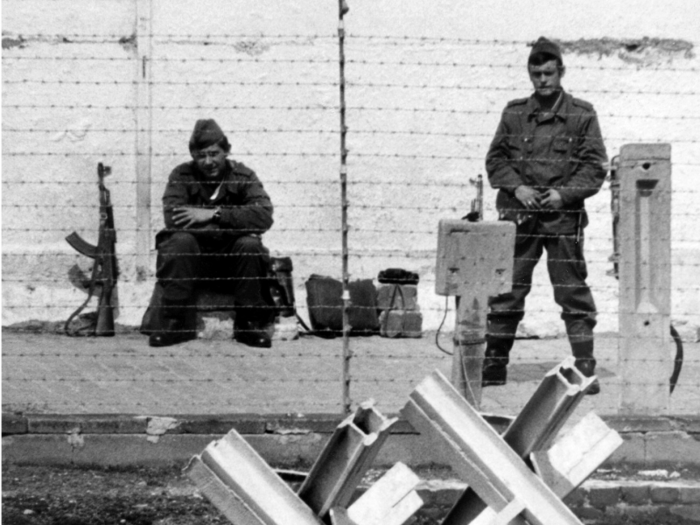
The US positioned tanks of its side of the Berlin checkpoint, facing East German troops, which prompted the Soviets to do the same. Fears ran high that a skirmish between the superpowers could rapidly escalate.
The standoff ended peacefully, but the Berlin Wall would last another 28 years.
Source: US State Department

After days of secret deliberations, President John F. Kennedy imposed a naval blockade around Cuba to block Soviet ships from delivering supplies.
Soviet leader Nikita Khrushchev agreed to withdraw the missiles in return for a US pledge not to invade Cuba, as it had done in the disastrous Bay of Pigs a year before. The US also secretly agreed to remove nuclear missiles stationed in Turkey, a NATO member.
Any conflict between the US and the USSR would likely have involved NATO via the alliance’s mutual-defense agreement.
Source: JFK Library

During exercise Able Archer 83, NATO officers practiced preparing for nuclear strikes amid a much larger war game involving 40,000 troops.
The war games seemed to trigger Russian fears that the US and NATO would launch a preemptive nuclear attack to decapitate Soviet leaders, and the USSR placed some of its nuclear force on alert.
Source: The Atlantic

The Bosnian Serbs, led by Radovan Karadzic, carried out an ethnic-cleansing campaign in Bosnia and Herzegovina designed to wipe out Bosnian Muslims.
The attacks prompted the UN to establish a no-fly zone, which NATO enforced. In February 1994, NATO planes shot down four Serbian jets — the first combat operation in NATO’s history.
Serbian forces perpetrated the Srebrenica massacre in July 1995, killing an estimated 8,000 civilians. NATO responded with a bombing campaign that lasted about a month; the Dayton Accords, which brought the Bosnian War to an end, were signed November 1995.
Source: NATO

NATO, this time without UN Security Council approval, launched a 78-day campaign in 1999 against Serbian forces who were carrying out the majority of the mass killings.
NATO jets flew 38,000 sorties, forcing the Serbs under President Slobodan Milosevic to withdraw their forces from Kosovo.
Serbian forces downed two NATO aircraft during the operation: a US Air Force F-117 stealth aircraft on March 27, 1999, and, on May 2 that year, an F-16 flown by Lt. Col. David Goldfein. Goldfein, now a general, is the current Air Force chief of staff.
NATO peacekeepers are still deployed to Kosovo.

NATO countries formed the International Security Assistance Force to defeat the Taliban in Afghanistan, where Al Qaeda had trained its fighters.
The NATO mission continues as Operation Resolute Support, while the US seeks a negotiated exit from the 17-year war. Two US service members were killed in Afghanistan this month, bringing the total to at least four this year and 65 since January 2015.
 A teenager accidentally hits the accelerator pedal, and a five-year-old boy loses his life in a tragic incident in Bengaluru
A teenager accidentally hits the accelerator pedal, and a five-year-old boy loses his life in a tragic incident in Bengaluru
 Amid growing political uncertainty in Pakistan, IMF expresses concern over its financial stability
Amid growing political uncertainty in Pakistan, IMF expresses concern over its financial stability
 OPINION: Balancing act or pure jugglery — navigating professional challenges as a working mother
OPINION: Balancing act or pure jugglery — navigating professional challenges as a working mother

Copyright © 2024. Times Internet Limited. All rights reserved.For reprint rights. Times Syndication Service.